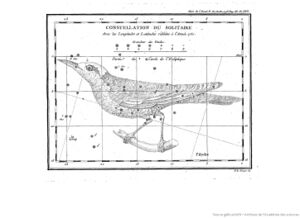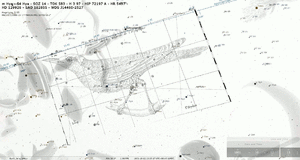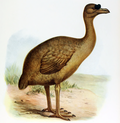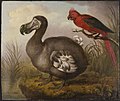Solitaire
This French term was used for the now-obsolete constellation Turdus Solitarius (= Solitaire = Noctua).
Etymology and History
The extinct constellations Turdus Solitarius and Noctua, which share some history and region of the sky, have brief summaries in Star Names - Their Lore and Meaning by Richard H. Allen (1899, pp. 418-419) and in Star Tales by Ian Ridpath (1988, p. 151) and have a dedicated chapter in The Lost Constellations by John C. Barentine (2015, ch. 29, pp.&nbs;449-464).
The classical constellation Hydra ends with the star Pi Hydrae. In early modern time, some astronomers extended the chain of stars towards Libra and even introduced yet another bird on its longer end (as traditionally, the Raven sits on the tail tip of Hydra). The constellation of "Solitaire" was first depicted in Pierre Charles Le Monnier's contribution to the Histoire de l'Académie royale des sciences ... avec les mémoires de mathématique & de physique... tirez des registres de cette Académie, from the French Academy of Science (Académie royale des sciences, Paris) 1776.
Ian Ridpath elaborates that the engraver Yves-Marie Le Gouaz (1742–1816) accompanied Pierre Le Monnier's announcement of the new constellation and states:
Unfortunately the bird shown on the engraving is not the Rodrigues solitaire as Le Monnier had intended, but rather a blue rock thrush, known as the solitaire of the Philippines. Whether the error was due to Le Monnier or Le Gouaz is unknown.
Bode (1801) in his famous Uranographia takes over the idea of this additional bird but depicts it slightly differently,
List of Identified Stars in Monnier's Map
Stars within the Constellation Area
| id | label | IAU desig. | description | IAU name | Vmag |
|---|---|---|---|---|---|
| 1 | gamma (Sco) | sigma Lib | in the heart/ chest | Brachium | 3.25 |
| 2 | - | E Hya | in the east claw | - | 4.4 |
| 3 | - | 60 Hya | at the edge of the wooden branch | - | 5.8 |
| 4 | - | 57 Hya | lowest in the east leg | - | 5.75 |
| 5 | - | 56 Hya | next to the lowest in the east leg | - | 5.2 |
| 6 | - | 55 Hya | the next one of these | - | 5.5 |
| 7 | - | m Hya | the uppermost in the legs, where they join the body | - | 5.05 |
| 8 | - | 4 Lib | the uppermost in the west leg | - | 5.7 |
| 9 | - | HIP 72488 | the one above the west leg, surrounded by a group of faint ones (7 to 8 mag) | - | 5.65 |
| 10 | - | 12 Lib | the northern one of the two between the heart and the legs | - | 5.25 |
| 11 | - | 14 Lib | the southern one of the two between the heart and the legs | - | 6.9 |
| 12 | - | 23 Lib | the faint one east of the heart | - | 6.45 |
| 13 | - | HIP 74732 | chain of three equidistant in the upper spine: the easternmost | - | 5.5 |
| 14 | - | HIP 73927 | chain of three equidistant in the upper spine: middle one | - | 6.1 |
| 15 | - | HIP 73884 | the fainter one below the middle one | - | 7.1 |
| 16 | - | KX Lib | chain of three equidistant in the upper spine: the westernmost | - | 5.75 |
| 17 | - | HIP 76106 | above the forehead | - | 5.52 |
| 18 | - | HIP 71816 | the three faint ones where the tail joins the body: uppermost | - | 7 |
| 19 | - | HIP 71295 | the three faint ones where the tail joins the body: middle | - | 6.45 |
| 20 | - | HIP 70961 | the three faint ones where the tail joins the body: lowest | - | 7.05 |
| 21 | - | HIP 70518 | where the wing meets the tail: upper | - | 6.6 |
| 22 | - | HIP 70261 | where the wing meets the tail: lower | - | 6.75 |
| 23 | - | 236 Vir | tip of the wing | - | 5.85 |
| 24 | - | HIP 69658 | tip of the wing | - | 5.5 |
| 25 | - | HIP 76569 | where the beak joins the head | - | 5.8 |
| 26 | - | HIP 72310 | the brighter one of the two faint in the middle of the body | - | 6 |
| 27 | - | HIP 72217 B | the fainter one of the two faint in the middle of the body | - | 7.3 |
| 28 | - | k Hya | western edge of the wooden branch | - | 4.75 |
| 29 | - | l Hya | western claw of Solitaire | - | 4.95 |
| 30 | - | HIP 75939 | in the eye of the Solitaire | - | 6.2 |
Bright Stars within the Frame, not within the constellation area
| id | Monnier's Label | IAU design. | description | IAU name | Vmag | |
|---|---|---|---|---|---|---|
| 1 | - | iota1 Lib | above the neck | - | 4.5 | |
| 2 | - | iota2 Lib | above the neck | - | 6.2 | |
| 3 | kappa Vir | kappa Lib | above the beak | - | 4.75 | |
| 4 | - | 41 Lib | above the head | - | 5.55 | |
| 5 | - | 10 Lib | above the rump | - | 6.25 | |
| 6 | - | 42 Lib | below the beak | - | 4.95 | |
| 7 | - | 36 Lib | edge of the frame | - | 5.1 | |
| 8 | e Vir | ups Lib | edge of the frame | - | 3.6 | |
| 9 | delta [Lup] | f Lup | in front of the wooden branch | - | 4.35 | |
| 10 | delta [Lup] | l Lup | below of the wooden branch | - | 4.9 | |
| 11 | - | 50 Hya | east of pi Hya | - | 5.05 | |
| 12 | - | pi Hya | tip of Hydra's tail | - | 3.25 | |
| 13 | - | 47 Hya | last(double) before the tail tip of Hya | - | 5.2 | |
| 14 | - | 48 Hya | last(double) before the tail tip of Hya | - | 5.75 | |
| 15 | - | 59 Hya | above the wooden branch | - | 6.3 | |
| 16 | - | HIP 76143 | in front of the chest | - | 6.9 | |
| 17 | - | HIP 70469 | the one west of the legs | - | 5.3 | |
Species of Bird
The bird was native to the Rodrigues Island, east of Madagascar & east of Mauritius in the Southern Indian Ocean. It is considered a species of doves and pigeons although they were flightless and much taller (size of the swans). The Rodrigues Solitaire is considered an endemisms that derives from Madagascar pigeons, while the Dodo is considered an endemism of the same pigeon at another island (Mauritius).
Picture of a Solitaire (1708). From Leguat, François (1891), The voyage of François Leguat of Bresse, to Rodriguez, Mauritius, Java, and the Cape of Good Hope. 2 Volumes., Edited and annotated by S. Pasfield Oliver, London: Hakluyt Society. It is a facsimile of a figure from: Leguat, François (1708), Voyage et avantures de François Leguat & de ses compagnons en deux isles desertes des Indes Orientales. 2 Volumes., London: Mortier (1708).
Emoji
The description reads:
A brown or gray dodo shown in full profile. Generally depicted with a curved yellow beak, small wings, a fluffy white tail, yellow or orange feet, and black talons.
May be used to represent dodos or the concept of being extinct.
Dodo was approved as part of Unicode 13.0 in 2020 and added to Emoji 13.0 in 2020.
Unicode: U+1F9A2
Transformations/ Variants
IAU Working Group Star Names
The brightest star of historical "Turdus Solitarius" was Sigma Librae, mag. 3.2, named Brachium by WGSN. It was suggested in 2023 to try naming another of its stars, if we can identify them reliably. The French "Solitaire" is an obvious name to use. The biological relative from the neighboring island, the Dodo, is much more popular and even has an emoji. Perhaps we should use this name, too and commemorate extinct animals. Or maybe use a double star for both, Solitaire and Dodo?
Suggestions:
- E Hya (4.41 mag, SIMBAD) is the second brightest star in the constellation, and is within the area of the bird in both versions
- m Hya (5.05 mag, SIMBAD), HIP 72197 = HR 5497, is "double or multiple".
- m Hya A has 5.46 mag - suggested name "Solitaire"
- m Hya B has 7.25 mag - suggested name "Dodo"
- 56 Hya (5.2 mag, SIMBAD)
The name was discussed and approved by the IAU WGSN in 202x. The WGSN chose ... (not to apply/ to apply the name to a neighbouring star/ to ...) in the IAU-CSN.
Weblinks
- Le Monnier's depiction of the Solitaire (Gallica)
- Bode's depiction of the Solitaire (eRARA Zurich)
- Ian Ridpath's "Star Tales", online edition
- Video explaining the common ancestor of both, Solitaires and Dodos.
- Video explaining reconstruction and taxonomy of the dodo





















